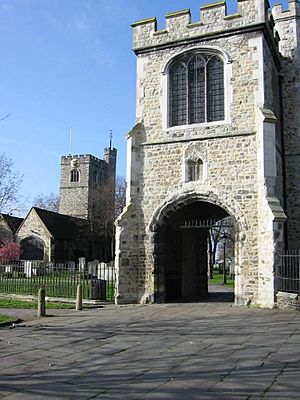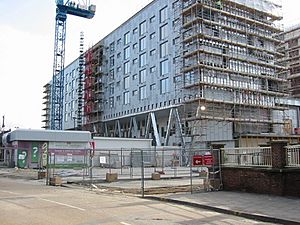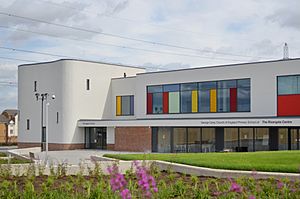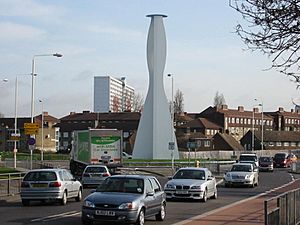Barking facts for kids
Quick facts for kids Barking |
|
|---|---|
 Barking Abbey curfew tower with St Margaret's Church in background |
|
| OS grid reference | TQ440840 |
| • Charing Cross | 8.8 mi (14.2 km) W |
| London borough | |
| Ceremonial county | Greater London |
| Region | |
| Country | England |
| Sovereign state | United Kingdom |
| Post town | BARKING |
| Postcode district | IG11 |
| Post town | LONDON |
| Postcode district | E6 |
| Dialling code | 020 |
| Police | Metropolitan |
| Fire | London |
| Ambulance | London |
| EU Parliament | London |
| UK Parliament |
|
| London Assembly | |
Barking is a suburban town in England, and forms part of the London Borough of Barking and Dagenham. It is 8.8 miles (14.2 km) east of Charing Cross and is one of 35 major centres identified in the London Plan. It was historically a fishing and agrarian settlement in the county of Essex and formed an ancient parish. Its economic history is characterised by a shift to market gardening, and industrial development to the south adjacent to the River Thames. The railway station opened in 1854 and has been served by the London Underground since 1908. As part of the suburban growth of London in the 20th century, Barking significantly expanded and increased in population, primarily due to the development of the London County Council estate at Becontree in the 1920s, and it became a municipal borough in 1931, and part of Greater London in 1965. In addition to an extensive and fairly low-density residential area, the town centre forms a large retail and commercial district, currently a focus for regeneration. The former industrial lands to the south are being redeveloped as Barking Riverside.
Contents
History
| 1881 | 16,848 |
|---|---|
| 1891 | 14,301 |
| 1901 | 21,547 |
| 1911 | 31,294 |
| 1921 | 35,523 |
| 1931 | 51,270 |
| 1941 | war # |
| 1951 | 78,170 |
| 1961 | 72,293 |
| # no census was held due to war | |
| source: UK census | |
Toponymy
Its name came from Anglo-Saxon Berecingas, meaning either "the settlement of the followers or descendants of a man called Bereca" or "the settlement by the birch trees". In AD 735 the town was Berecingum and was known to mean "dwellers among the birch trees". By AD 1086, it had become Berchingae as evidenced by the town's entry in the Domesday Book.
In British slang "Barking" is short for "barking mad", and Barking is sometimes cited as the origin of the phrase, attributed to the alleged existence of a medieval insane asylum attached to Barking Abbey. However, the phrase first appeared in the 20th century.
Local government
Barking was a large ancient parish of 12,307 acres (49.80 km2) in the Becontree hundred of Essex. It was divided into the wards of Chadwell, Ilford, Ripple and Town. A local board was formed for Town ward in 1882 and it was extended to cover Ripple ward in 1885. In 1888 Ilford and Chadwell were split off as a new parish of Ilford, leaving a residual parish of 3,814 acres (15.43 km2). The parish became Barking Town Urban District in 1894 and the local board became an urban district council. The urban district was incorporated as the Municipal Borough of Barking in 1931. It was abolished in 1965 and split, with the majority merged with the former area of the Municipal Borough of Dagenham to form the London Borough of Barking. The part west of the River Roding, which included part of Beckton, became part of the London Borough of Newham. In 1980 the borough was renamed Barking and Dagenham. Barking's population is 48,340 (2011) which includes the Abbey, Eastbury, Gascoigne and Longbridge wards.
Urban development
The manor of Barking was the site of Barking Abbey, a nunnery founded in 666 by Eorcenwald, Bishop of London, destroyed by the Danes and reconstructed in 970 by King Edgar. At the Dissolution of the Monasteries in 1536, Barking Abbey was demolished; the parish church of St Margaret, some walling and foundations are all that remain. The parish church is an example of Norman architecture; Captain James Cook married Elizabeth Batts of Shadwell there in 1762, and it is the burial place of many members of the Fanshawe family of Parsloes Manor.
A charter issued between 1175 and 1179 confirms the ancient market right. The market declined in the 18th century but has since been revived.
Fishing
Fishing was the most important industry from the 14th century until the mid-19th. Salt water fishing began before 1320, when too fine nets were seized by City authorities, but expanded greatly from the 16th century. Fisher Street was named after the fishing community there. From about 1775 welled and dry smacks were used, mostly as cod boats, and rigged as gaff cutters. Fishermen sailed as far as Iceland in the summer. They served Billingsgate Fish Market in the City of London, and moored in Barking Pool. Samuel Hewett, born on 7 December 1797, founded the Short Blue Fleet (England's biggest fishing fleet) based in Barking, and using smacks out of Barking and east coast ports. Around 1870 this fleet changed to gaff ketches that stayed out at sea for months, using ice for preservation of fish produced by flooding local fields in winter. Fleeting involved fish being ferried from fishing smacks to steamer carriers by little wooden ferry-boats. The rowers had to stand as the boats were piled high with fish boxes. Rowers refused to wear their bulky cork lifejackets because it slowed down their rowing. At first the fast 50-foot gaff cutters with great booms projecting beyond the sterns raced the fish to port to get the best prices.
Until about 1870 the trade was mostly in live fish, using welled smacks in which the central section of the hull, between two watertight bulkheads, was pierced to create a 'well' in which seawater could circulate. Cod caught live were lowered into this well, with their swim bladders pierced, and remained alive until the vessel returned to port, when they were transferred to semi-submerged 'chests,' effectively cages, which kept them alive until they were ready for sale. At this point they were pulled out and killed with a blow on the head before being despatched to market, where because of their freshness they commanded a high price. People who practised this method of fishing were known as 'codbangers.' By 1850 there some 220 smacks, employing some 1,370 men and boys. The boats were typically 75 feet (23 m) long carrying up to 50 tons. During the wars of the 17th and 18th century they were often used as fleet auxiliaries by the Royal Navy, based at nearby Chatham Dockyard. The opening of rail links between the North Sea ports and London meant it was quicker to transport fish by train straight to the capital rather than waiting for ships to take the longer route down the east coast and up the River Thames. By the 1850s the Thames was so severely polluted that fish kept in chests quickly died. Consequently, the fishery slipped into decline in the second half of the nineteenth century. The decline was hastened by a storm in December 1863, off the Dutch coast, which caused the deaths of 60 men and damage estimated at £6–7000. Many of its leading figures, including Hewett & Co, moved to Great Yarmouth and Grimsby. By 1900 Barking had ceased to be a fishing port, leaving only street and pub names and a large modern steel sculpture entitled "The Catch" as a reminder of its former importance. The sculpture is on the roundabout at the end of Fanshawe Avenue. The local fishing heritage is recorded at Valence House Museum.
Economic development
Boat building has a long history, being used for the repair of some royal ships of Henry VIII. In 1848, 5 shipwrights, 4 rope- and line-makers, 6 sail-makers and 4 mast-, pump-, and block-makers are listed in a local trade directory. Hewett & Co continued in boat building and repair until 1899. Other industries replaced the nautical trades, including jute spinning, paint and chemicals manufacture. By 1878 Daniel de Pass had opened the Barking Guano Works (later de Pass Fertilisers Ltd, part of Fisons) at Creekmouth. Creekmouth was also the site of the major Barking Power Station from 1925 until the 1970s, burning coal shipped in by river; the current station known as Barking is further east near Dagenham Dock. In the 20th century new industrial estates were established, and many local residents came to be employed in the car plant at Dagenham.
Thames disaster
On 3 September 1878 the iron ship Bywell Castle ran into the pleasure steamer Princess Alice in Gallions Reach, downstream of Barking Creek. The paddle steamer was returning from the coast via Sheerness and Gravesend with nearly 800 day trippers. She broke in two and sank immediately, with the loss of more than 600 lives, the highest single loss of civilian lives in UK territorial waters. At this time there was no official body responsible for marine safety in the Thames, the official enquiry resolving that the Marine Police Force based at Wapping be equipped with steam launches to replace their rowing boats and be better able to perform rescues.
Geography
Town centre

Barking Town Centre is being regenerated through a number of schemes. It is one of the most deprived areas of Barking. The Abbey and Gascoigne wards in the town centre are ranked 823rd and 554th respectively - within the 10% most deprived wards in the country.
The regeneration intends to achieve a more sustainable economy by investing in new quality retail outlets and creating a business centre. The regeneration aims to enable people to widen their employment prospects, mainly through creating new "retail and business accommodation", which will provide employment and increase the income for both existing and new residents. The regeneration also aims to improve people's skills. This is mainly achieved through the Barking Learning Centre; which aims to improve literacy, numeracy and other basic skills people may be lacking due to a previous lack of educational development. It currently acts as a borough-based learning facility. The centre was officially opened on 10 June 2008 by John Denham, Secretary of State for Innovation, Universities and Skills.
The town centre development intends to improve the quality and range of housing, aiming to create 4,000 new homes: 25% will be intermediate housing, affordable for local residents to buy. The will be 4,000 socially rented homes, making it easier for first-time buyers and people with low incomes to rent a property. To help make the development more sustainable, all private sector homes were to meet the Government's decency standards by 2010.
Plans for the new town square were unveiled in September 2007. The development is part of the Mayor of London's 100 Public Spaces, and it was completed in 2008, designed by muf architecture/art and Allford Hall Monaghan and Morris. It won The European Prize for Urban Public Space.
Roding Riverside
Not to be confused with Barking Riverside, Roding Riverside is a name given to an area of Barking comprising the stretch of Abbey Road south of St Pauls Road, which runs parallel to the River Roding / Barking Creek and the area between. The quarter is post-industrial. Many buildings are late 20th century or early 21st century residential and commercial buildings, but some are Victorian industrial buildings adapted for use in arts and leisure fields with a view to regenerating the area in part by drawing out the industrial heritage architecture.
One such Victorian building is a former Malthouse. Adjacent to this building stands a cluster of buildings together styled the Ice House Quarter, which includes a former Ice House and a former Boat House
A new building, Ice House Court references the old Ice House and provides more artist studio space.
Barking Riverside
The Barking Riverside development is part of the London Riverside project, which aims to regenerate the Thames riverside area of East London through new homes, jobs, and services. Barking Riverside consists of 350 acres (1.4 km2) and the public will have access to two kilometres of Thames river front. The Rivergate Centre, designed by van Heyningen and Haward Architects, provides the civic facilities for the initial phase of Barking Riverside, while a new square and 3FE primary school, which includes embedded community facilities, a nursery, church, flexible office suites for the PCT and Community Development Trust, as well as a MUGA and sports pitches are also planned. As yet unbuilt, the second phase provides 90 flats, local shops and a neighbourhood police post.
 |
Woodgrange Park | Ilford & Loxford | Mayesbrook Park |  |
| East Ham | Upney | |||
| North Beckton | Beckton | Creekmouth |
Demography
Barking is highly ethnically diverse, quite in stark contrast to Dagenham. In the 2011 census, the largest ethnic group in Abbey ward (which covers Barking town centre) was Pakistani at 17%, followed by 16% White British, 15% Black African, 13% Indian and 11% Other White. The town centre's proximity to both East Ham and Ilford may explain its high diversity among different ethnics. Gascoigne ward (southern Barking) was 26% White British, 26% Black African and 13% Other White. Longbridge ward (eastern Barking) was 35% White British, 18% Bangladeshi and 11% Pakistani. The wards of Dagenham meanwhile are all White British-majority, and Black Africans are the only significant minorities there, whereas the Asian community is small by contrast to Barking.
Transport
The town is situated north of the A13 road and east of the River Roding near its confluence with the River Thames in east London. The South Woodford to Barking Relief Road (part of the A406 North Circular Road) runs through the Roding Valley, and access to the town centre is by its junction with the A124, which until the late 1920s was the main route to and from London. Barking station is a local transport hub and is served by the London Underground, London Overground, c2c and London Bus and East London Transit routes. The east of Barking is served by Upney tube station.
Culture
"A Man Needs a Maid" and "There's a World" were recorded by Neil Young with the London Symphony Orchestra at Barking Assembly Hall for Young's classic album Harvest, which was released in 1972.
Local media
Bedrock is the local hospital radio service available online to the local area and broadcasting a range of health-related information focused on the local King George Hospital, London and Queen's Hospital.
Sport
Barking F.C. are a non-league side, and records indicate they were founded as early as 1865. The team merged with East Ham F.C. to form Barking & East Ham United in 2001. This club later struggled and went out of business, but Barking F.C. was later reformed once again. Cricket, basketball and hockey are also popular sports in the area.





